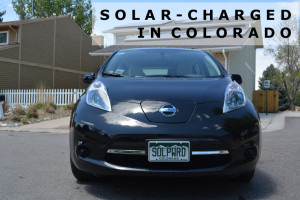
 I’ve been living for about a month in a co-housing condo community called Highline Crossing Cohousing in Littleton, Colo.
I’ve been living for about a month in a co-housing condo community called Highline Crossing Cohousing in Littleton, Colo.
I really like it here — I’ve met lots of friendly people, gone to several events, played ping pong with my kids in the community center, even helped out on a quarterly clean-up day Saturday.
It’s clearly been the right decision for me — but, as I noted in a blog entry a few weeks ago, one drawback is that I do not own my own roof. Not the roof over my townhome and not the roof over my garage.
I am itching to get back to solar-charging my 2014 Nissan LEAF, but it’s fairly likely I will need to wait months and months as a proposal to add six to eight solar panels on my garage + a 220 volt outlet (or EV charger) + a possible Tesla Powerwall, winds its way through the HOA association decision-making/approval/hopefully not rejection process.
In theory, my ideal scenario would be one where I get approval to put a 2 kW solar system on my garage roof + a Tesla Powerwall + an EV charger. The goal here would not be to save money — and, with a Powerwall in the equation, I’m guessing I might not save money — but instead to achieve fueling independence, flipping “it” to Utility Monopoly (in my case, Xcel Energy) and to Big Oil/OPEC, etc. all at once.
However, in addition to not quite understanding what the best approach might be to getting my HOA on board with my plan, I have to confess I do not fully grasp how a solar rooftop + Powerwall + EV charger set up would work.
I have a bunch of questions –>
- How would the solar energy stored in a Powerwall during the day, when I am mostly not at home, but at work with my Nissan LEAF, get from the Powerwall into my LEAF’s battery? Could I charge my LEAF directly from the Powerwall? More important perhaps: Would the Powerwall be able to fill the LEAF’s battery up or not?
- Would everything need to be installed at the same time, so that the components of the set-up would be properly connected and able to “communicate” and work with one another? Or, could I first install a 220-volt outlet, then a solar system, and eventually a Tesla Powerwall awhile and still have a “seamless” home solar-EV charging system?
- I am quite unclear about the utility meter question: My HOA has 40 garage units whose collective electricity use is measured by a SINGLE utility meter and the electricity bill for the garages is paid through HOA dues. I’m pretty sure I would like to have my own utility meter, but — is this possible? How much would it cost? Would Xcel add a meter for me? If I could not get an individual meter for my solar system and my 220-volt outlet charger and had to stay connected with/together with 39 other garages and their electric use on a single meter, would my utility, Xcel Energy allow me to have a solar system on my garage — whose roof, once again, I do not own, but which is so-called “common property” of the entire HOA?
I just sent in a request for information from Tesla. I guess I will call an electrician of some sort to ask about the addition of a 220-volt dryer outlet and what this might entail given the current electrical wiring of my garage. Finally, I will call a couple of solar companies and have them take a look at the situation I have and see what they suggest.
I probably will call SunRun — because they installed our 5.5 kW solar system at 4000 S. Atchison Way in Aurora, Colo. in June 2010 (actually, REC Solar installed the system, but the residential side of REC Solar was bought out by SunRun three years after our installation). I think I’ll call Namaste Solar as well because our neighbors back in Aurora, who went solar about two years after we did, in part inspired by us, used Namaste and were satisfied with them.
Hopefully, some of the “experts” at Tesla, SunRun, Namaste and some local electrician will have some answers for me in terms of some of the questions above — although, honestly, I wonder if they will have ever encountered a situation like mine — where I want to solar-charge an EV in a condo HOA where I don’t own the roof and where I do not even have my own utility meter for the garage over which I would like to place a 2 kW solar system.
I’m guessing this type of situation is probably quite rare, don’t you think? 
 As I’ve noted in a couple of
As I’ve noted in a couple of 

 The promotional video below, produced by
The promotional video below, produced by 









 I was just surfing and Googling around on the topic of solar-charged driving, EV + PV, etc. when I came across a very interesting
I was just surfing and Googling around on the topic of solar-charged driving, EV + PV, etc. when I came across a very interesting 

 Quite frequently someone will post to a
Quite frequently someone will post to a 




 So, I am working toward hopefully getting solar up in the cohousing community that I moved into just six months ago,
So, I am working toward hopefully getting solar up in the cohousing community that I moved into just six months ago, 




 Congratulations, Deena. And thank you for driving another electric vehicle powered by renewable energy.
Congratulations, Deena. And thank you for driving another electric vehicle powered by renewable energy.








